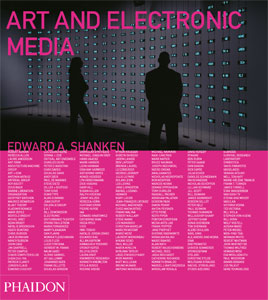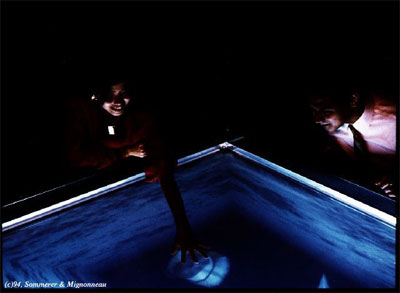
Edward A. Shanken’s new book Art and Electronic Media (Themes & Movements), published by Phaidon Press, presents a rich and comprehensive overview of the history of electronic media art practices in the twentieth century, focusing mostly on work produced in the United States, Canada, and Europe. The book balances the historical and the contemporary, the analytic and the particular, with style and critical rigor.
The text is organized thematically in order to cover major topics in the field: Motion, Duration, Illumination; Coded Form and Electronic Production; Charged Environments; Networks, Surveillance, Culture Jamming; Bodies, Surrogates, Emergent Systems; Simulations and Simulacra; and Exhibitions, Institutions, Communities, Collaborations. Given the extensive breath, in historical accounts and details, this organization system presents the reader with a convenient way to access a historical period, artist, or practice of their particular interest. Each theme reappears three times throughout the book, in each of the three main sections: Survey, Works, and Documents (a division that is consistent with previous volumes published in this Phaidon series).
Quality research into the history of electronic media art production, exhibition, and conception is consistent throughout. The section on "Networks," for instance, includes an insightful contextualization of new internet-based art with pre-network art, such as Hans Haache’s 1969 News, an installation that involves a series of Teletype machines set to receive and print local, national, and international news in real time. Shanken’s placement of current genres in these historical frameworks not only enhances our appreciation of the newer practices but also develops an understanding of the historical origins of net, systems, or environmental art.
Over 200 colorful images accompany the text, many of them projects that have not been exhibited widely. One example is the photograph of Christa Sommere and Laurent Mignonneau’s A-Volve (1994-95), a beautiful image that draws one into the description of the piece: an installation involving a pool of water in which users can create and “observe artificial life forms by interacting with virtual fish-like creatures ‘swimming’ in a pool of glass water.” The creature will survive as long as the adaptability features that it has been given will last in the environment. “A-Volve bridges virtual and real worlds.” The details in the photo documentation capture the liminal magic of the piece.

The third section of the book contains a compilation of artists’ biographies, and noted critics and artists’ writings. Highlights include texts by John Cage, Antonin Artaud, Bertolt Brecht, Gene Youngbloood, Nam June Paik and many others. To be sure, Shanken’s Art and Electronic Media will become a staple in the field: the go-to sourcebook for years to come.
Art and Electronic Media will have two US book launches: June 7th, 3pm, at the Exploratorium in San Francisco and on June 18, 6:30pm, at Bitforms Gallery, New York City.

